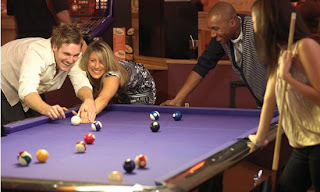
The game is generally regarded to have originated in the latter half of the 19th century. Billiards had been a popular activity amongst British Army officers stationed in India, and variations on the more traditional billiard games were devised. One variation, devised in the officers' mess in Jabalpur during 1874 or 1875, was to add coloured balls in addition to the reds and black which were used for pyramid pool and life pool.
The game of snooker grew in the latter half of the 19th century and the early 20th century, and by 1927 the first World Snooker Championship had been organised by Joe Davis who, as a professional English billiards and snooker player, moved the game from a pastime activity into a more professional sphere. Joe Davis won every world championship until 1946 when he retired. The game went into a decline through the 1950s and 1960s with little interest generated outside of those who played. Things saw some improvement when in 1969, when David Attenborough who was then a top official of the BBC, commissioned the snooker tournament Pot Black to demonstrate the potential of colour television, with the green table and multi-coloured balls being ideal for showing off the advantages of colour broadcasting.
The object of the game is to score more points than the opponent by potting balls in a predefined order. At the start of a frame the balls are positioned as shown and the players take it in turns to hit a shot in a single strike from the tip of the cue, their aim being to pot one of the red balls and score a point. If they do pot at least one red, then it remains in the pocket and they are allowed another shot - this time the aim being to pot one of the colours.
If successful, then they gain the value of the colour potted. It is returned to its correct position on the table and they must try to pot another red again. This process continues until they fail to pot the desired ball, at which point their opponent comes back to the table to play the next shot. The game continues in this manner until all the reds are potted and only the 6 colours are left on the table; at that point the aim is then to pot the colours in the above order. When a colour is potted in this phase of a frame, it remains off the table. When the final ball is potted, the frame is over and the player with the most points wins it. A match where five frames would be the winner is called a "best of nine", because that would be the maximum number frames that could be played.
Tuesday, May 26, 2009
Snooker
Posted by Naresh Negi at 10:11 AM
Subscribe to:
Post Comments (Atom)

0 comments:
Post a Comment